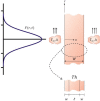Estimating 225Ac yield in thorium metal targets
- PMID: 37740000
- PMCID: PMC10516867
- DOI: 10.1038/s41598-023-41687-0
Estimating 225Ac yield in thorium metal targets
Abstract
In this work we estimate the yield of the radioisotope [Formula: see text] in a thorium metal target geometry similar to that described by Roberston et al.. We do so in three different yet complimentary studies. In the first study, we pose a three-way coupled time-dependent model describing beam position, temperature field, and local growth of the activity of the radioisotope and solve this numerically. In the second study, we present an analytical solution of the model equations for a generalized solid target in the "beam-thin" limit, i.e. where only a small fraction of the incoming energy of the proton beam is deposited into the thorium material. In the third study, we use the insight gained from the analytical solution and describe an operating strategy to maximize yield by modulating the beam flux temporally.
© 2023. Springer Nature Limited.
Conflict of interest statement
The authors declare no competing interests.
Figures





References
-
- Krasnov N. Thick target yield. Int. J. Appl. Radiat. Isotopes. 1974;25:223–227. doi: 10.1016/0020-708X(74)90031-3. - DOI
-
- Schlyer, D. et al. Cyclotron produced radionuclides: Principles and practice. In IAEA Technical Reports Series 465 (2008).
-
- Robertson AK, Lobbezoo A, Moskven L, Schaffer P, Hoehr C. Design of a thorium metal target for 225ac production at Triumf. Instruments. 2019;3:18. doi: 10.3390/instruments3010018. - DOI
-
- O’Brien E, Doster J, Nortier F, Olivas E, Stokely M. Two-way multi-physics coupling for modeling high power rbcl isotope production targets. Nucl. Instrum. Methods Phys. Res. Sect. B: Beam Interact. Mater. Atoms. 2018;433:15–22. doi: 10.1016/j.nimb.2018.07.022. - DOI
-
- Lenz J, et al. Gas target coupled density/proton heat load iterative cfd analysis for a xe124 production target. Nucl. Instrum. Methods Phys. Res. Sect. A: Accel. Spectrom. Detect. Assoc. Equip. 2011;655:111–117. doi: 10.1016/j.nima.2011.06.033. - DOI
LinkOut - more resources
Full Text Sources

